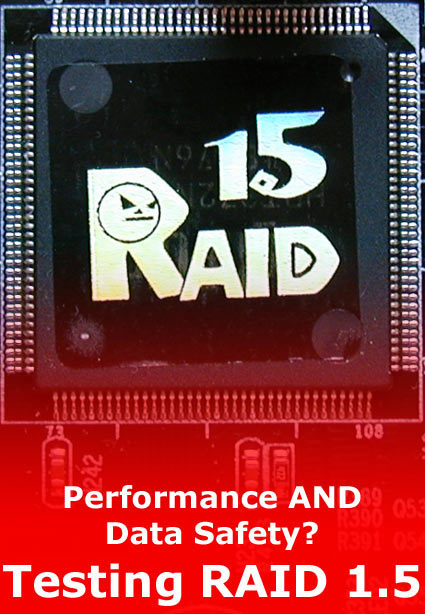RAID 1.5 With IDE: Added Value Or Eyewash?
RAID 1.5 With Two Hard Drives: Added Value Or A Marketing Gag?

More and more people are beginning to prefer a RAID array to a simple hard drive. Private users are switching to take advantage of significantly higher transfer rates. Professional users are trying to protect themselves against any drive defects.
RAID controllers are popular, practical add-ons that motherboard producers like to slap onto their products. In the simplest of cases, you'll get an additional IDE controller for hooking up even more drives. If you like to lean on your computer, you can create your own RAID array from two or four hard drives.
In fact, two RAID modes are found in many home systems and in simple server systems: RAID 0, known as striping, raises the data transfer rate; RAID 1, also called mirroring, permanently synchronizes (mirrors) the contents of one hard drive with its twin, effectively halving your overall storage capacity.
There's no doubt that RAID 0 is the fastest method and RAID 1 the safest. You will really experience the benefits of RAID 1 if your hard drive fails - the system will continue functioning and you can return your RAID to normal functioning once the defective drive has been replaced. RAID 0, on the other hand, throws security overboard in favor of capacity and peformance: the more drives you have, the more likely a defective drive will cause your system to crash.
But surely there must be a RAID mode that provides data security and higher performance than a single hard drive - right? Sure - it's called RAID 5. This RAID mode distributes data and parity information over no less than three hard drives. It requires a powerful controller, though, because you need a small RISC chip to calculate the parity data (XOR). A cheaper alternative is RAID 01 or 10, which works with four hard drives, and mirrors two RAID 0 arrays (0+1, or vice versa: 1+0).
While RAID 5 is not available as an onboard solution, RAID 01 and 10 are.
The costs, however, are still mighty high. The best thing for a small system would be somewhere between RAID 1 and RAID 5. And that is precisely what DFI and HighPoint have come up with. According to the manual for the latest LANParty series mainboards, the HPT372N can also handle RAID 1.5 with two hard drives. We decided to give it a spin.
Get Tom's Hardware's best news and in-depth reviews, straight to your inbox.
Current page: RAID 1.5 With Two Hard Drives: Added Value Or A Marketing Gag?
Next Page HighPoint HPT372N-
lifeisstudy So RAID 1.5 won't work because the heads of the disk still need to move to the next data block to read... If you skip blocks, you still have to move past them.Reply
What about RAID 1.5 with Solid State disks. You have nothing to move, yet you can double your read speed with mirroring. Sounds perfect for server caches.